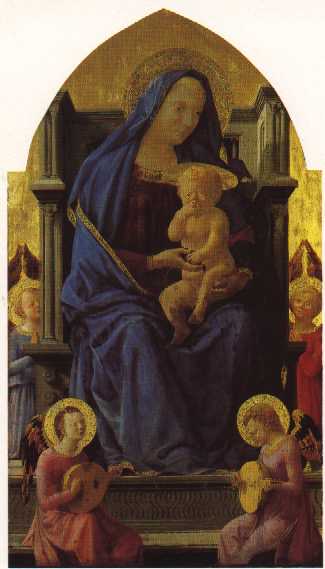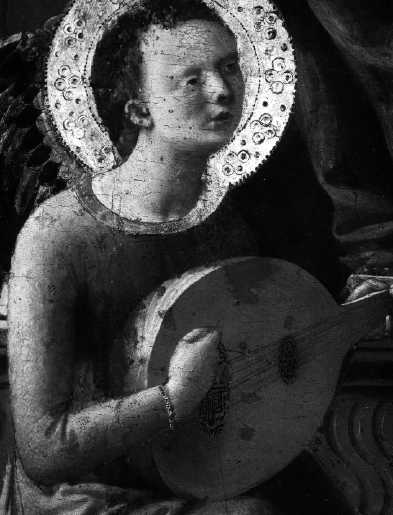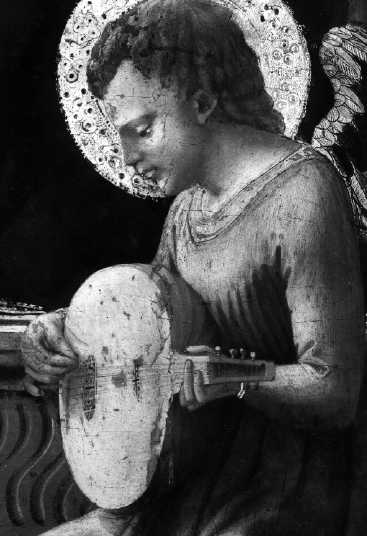

The Virgin and Child, 1426, Masaccio (1401 - 1428)
National Gallery, London. No. 3046

The Virgin and Child, 1426, (Detail) Masaccio (1401 - 1428)
National Gallery, London. No. 3046

The Virgin and Child, 1426, (Detail) Masaccio (1401 - 1428)
National Gallery, London. No. 3046
|
The Virgin and Child, 1426, Masaccio (1401 - 1428)
For us one of the interesting things is this first appearance of the five course lute in art. While the left hand lute is arguably a four course instrument with the top course doubled, it might just be a five course with the top two courses single, which would be highly unusual at this date. However the right hand lute is clearly a five course instrument with four double courses and a single top course.
There has been some damage and repainting but fortunately for us this retouching has been done in the old-fashioned manner leaving the alterations obvious. Therefore we can be clear that the neck to body joints are both in the late medieval curved form, unlike the later renaissance hard corner which became necessary as the number of courses increased and made the neck wider. This is not a universal feature of medieval lutes but it is more common than the angled joint.
Both lutes show the other characteristic of medieval lutes; two roses with the smaller one between the main rose and the fingerboard. The very steep perspective has clearly intrigued and taxed Masaccio's skill so we cannot be entirely sure that the perceived position of the main rose is actually where it appears to be. Notice too that we do not have any echo of the Moorish six pointed star which became a feature of renaissance lutes. This argues against the view that this feature was a link back to the Moorish origins oof the lute as an 'Ud. It seems to have been a particularly renaissance design. These roses show, if anything a strong cross form suggesting perhaps a response to the Christian position of the painting.
Both lutes are being played with a thin plectrum which looks like a feather quill strip and, although the thumbs are prominent and high up on the neck, it is quite clear that they are not being used to stop the fifth course.
The pegs are interestingly very ragged, they have pushed through rather authentically unevenly, leading one to trust the portrayal as based more on observation than iconographic convention. Which confirms Masaccio's art historical position as one of the first realists in the line of Giotto. In this respect notice how the wings of the angels are formalised and put in a different plane to the bodies; the impression is of real lute-players whose heavenly attributes have been somewhat tacked on.
Finally, notice that both lutes are what we would call multi-rib instruments, a design which we associate mostly with Venetian lutes in the sixteenth century. There is even a hint in the left hand lute of its being made of heart/sap yew, though I wouldn't want to be definite about this without going up to London and checking.
|
|
If anyone has any comments about these pictures which differ from or expand
on mine, please do either email me direct or submit them to the lutenet at antispam/lute@cs.dartmouth.edu and I will add them to this page. Do please adjust this address by hand to remove antispam/ |
| Lutes | Bows | |
| History of the Lute | Build your own Baroque Lute | Build your own Renaissance Lute |
Copyright 1999 by David Van Edwards